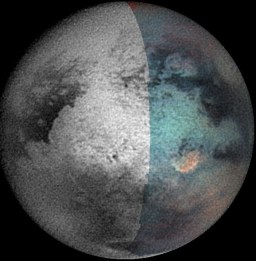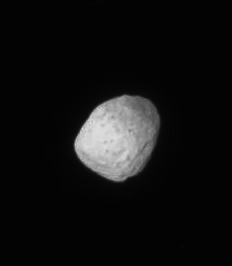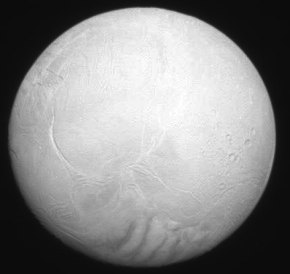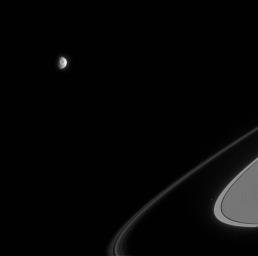
I have to admit that this released caught me off guard. I wasn't expecting this for a few more weeks. Regardless, the ISS and VIMS teams have announced the discovery of a very bright spot on Titan. This feature was first noticed in ISS images as a concave-north "smile-shaped feature south-east of Xanadu. In the image from December above, combined with VIMS false color, the smile has an odd, crenulated margin. VIMS was able to observe this feature during the T4 and T5 flybys earlier this year. In VIMS images, the feature is a very bright spot at 5 microns (as opposed to the ISS image which used a filter centered at 0.938 microns). The smile feature bounds the bright spot to the south and west, though it extends farther to the west (this may be an emission angle effect since the bright spot is near the limb in VIMS images).
So what is the bright spot? The spectrum obtained by VIMS is very different from other landforms on Titan, save a very bright region in southwestern Xanadu (seen in
VIMS and
ISS images). It is not a cloud since clouds generally appear brighter than their surroundings at all methane-window, VIMS wavelengths (and are seen slightly away from the center of those windows since they are at higher altitude) while this spot is much brighter than its surroundings at 5 microns and is only slightly above at shorter wavelengths. In addition, VIMS and ISS images since T0 last July show that the spot hasn't changed in 9 months. The press release does mention topographically controlled clouds, however.
Another possibility is that the spot is a hot spot, not unlike the hotspots seen on Io observed by the SSI and NIMS instruments on Galileo, resulting from volcanic activity that is much warmer than its surroundings. In Titan's case, the hot spot would result from water-ammonia cryovolcanism, rather than basalt. The hotspot could also result from a recent large impact on Titan at that site. The best test for seeing the thermal signature of a hotspot comes by observing Titan's night side, where the only signal coming from the surface would be from emission, whereas day side detections have to be seperated from reflected sunlight. So far no thermal anomalies have been discovered in night side observations, but a test for this feature will come on July 2, 2006 when this feature is observed at night.
Finally, this spot could simply be compositionally distinct from the rest of the surface (a hypothesis I have to admit in the interest of disclosure I favor). In the press release, Alfred McEwen states, "This bright patch may be due to an impact event, landslide, cryovolcanism or atmospheric processes. Its distinct color and brightness suggest that it may have formed relatively recently." It would seem to me that this spot should be a patch of relatively clean ice, again this feature would have to be relative young for it not be covered in haze crud.
Anyways, a very interesting discovery by the VIMS team. It is also nice to finally have some collaboration between different instrument teams since it definitely appears that some collaboration is necessary for us to understand what is going on here.
Two images releases are associated with this news item:





